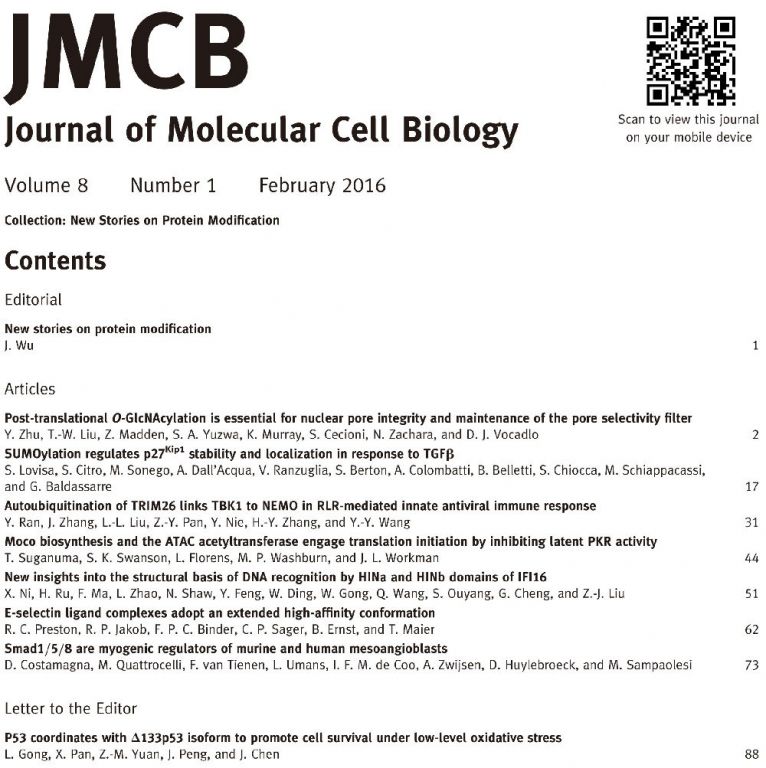博文
JMCB新年第一期(About Protein Modification )上线啦!!!
||
JMCB-2016年第一期文章上线啦!
这期COLLECTION的主题为New stories on protein modification
具体内容见: https://academic.oup.com/jmcb/issue/8/1

本期刊物导读:
Further to the last issue, titled 'Protein Modification for Immune Regulation' (Wu, 2015), JMCB starts the new year with a collection of research papers sharing interesting stories about how protein modification participates in various physiological or pathological processes.
Protein glycosylation plays important roles in a variety of biological processes. A recent study has reported that O-glycosylation of the nuclear pore complex (NPC) is conserved within metazoans. In the first article of this issue, scientists from Dr Vocadlo's laboratory investigated the function of NPC glycosylation by O-linked N-acetylglucosamine (O-GlcNAc) in the nuclear pore. The authors showed that inhibition of O-GlcNAc increased the degradation of cellular nucleoporins (Nups), leading to loss of Nups from the NPC and dysfunction of the pore selectivity filter. These findings indicate that post-translational O-GlcNAcylation is essential for the maintenance of NPC composition and nuclear pore selectivity permeability barrier.
Recent evidences suggest that SUMOylation regulates the TGFβ signaling pathway by modulating the stability and subcellular localization of its target proteins. In this issue, Dr Baldassarre's group revealed the link between SUMOylation and p27Kip1 function in response to TGFβ stimulation. The authors showed that the CDK inhibitor p27Kip1 was SUMOylated on lysine 134 by small ubiquitin-like modifier 1 (SUMO1) in response to TGFβ treatment. Such post-translational modification increased p27Kip1 stability by decreasing its binding to CDK2 and subsequent nuclear proteasomal degradation. Thus, p27Kip1 SUMOylation was required for its nuclear accumulation and proper cell cycle exit following TGFβ treatment.
Innate immune response is vital for host defense against viral infection. In this issue, Dr Wang's laboratory identified tripartite motif 26 (TRIM26) as a key regulator for TBK1 activation in RIG-I-like receptor-mediated innate immune response. Upon RNA viral infection, TRIM26 went through autoubiquitination as an E3 ligase, and recruited NF-κB essential modulator (NEMO) to a protein kinase TBK1, which is physically associated with TRIM26 independent of viral infection. The bridging of TBK1 to NEMO resulted in TBK1 activation, which plays a critical role in antiviral innate immune response by engaging downstream of multiple pattern-recognition receptors (PRRs) to mediate IRF3 phosphorylation and activation.
Protein phosphorylation is the most common post-translational modification involved in many biological regulations. In this issue, Dr Suganuma and colleagues reported their new finding that protein phosphorylation also participated in the regulation of translation initiation. The authors showed that molybdopterin (MPT) synthase and the Ada Two A containing (ATAC) acetyltransferase could directly interact with a protein kinase PKR, and suppressed its latent autophosphorylation. On the one hand, the inhibition of PKR phosphorylation suppressed downstream c-Jun activation and subsequent stress-responsive transcription. On the other hand, the inhibition of PKR phosphorylation prevented phosphorylation of eIF2α and sequestration of the guanine nucleotide exchange factor eIF2B, thus favoring the translation.
References
Wu, J. (2015). Protein modification for immune regulation. J. Mol. Cell Biol. 7, 493.
https://wap.sciencenet.cn/blog-1045694-957894.html
上一篇:[转载]《2015年中国学术期刊国际、国内影响力研究报告》发布
下一篇:Editor's choice: About human MPT synthase and ATAC (FREE!)
全部作者的其他最新博文
全部精选博文导读
相关博文
- • Minerals线下恳谈会:履践致远、与时偕行——对话中国科学院广州地球化学研究所期刊合作学者
- • 聚英才 建高地 | 北京理工大学“特立青年学者”全球招聘开启
- • 700年后日本或濒临灭绝?日本学者推算预测:届时或仅剩1名15岁以下孩子
- • [转载]【同位素视角】非英语母语学者如何区分’e.g.’, ‘i.e.’, ‘namely’与‘such as’等混淆难题
- • 美国佐治亚大学等机构学者:刈割策略对Bulldog 805紫花苜蓿+Tifton 85狗牙根混播草地产量及品质的影响
- • 美国堪萨斯州立大学、密苏里大学等机构学者研究成果:土壤水分管理策略和品种多样性对紫花苜蓿产量、营养品质和农场盈利能力的影